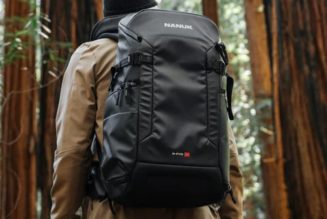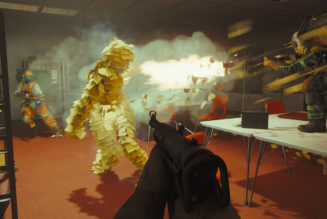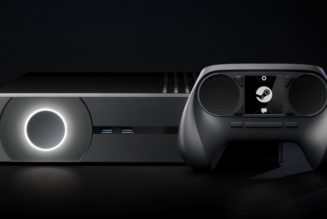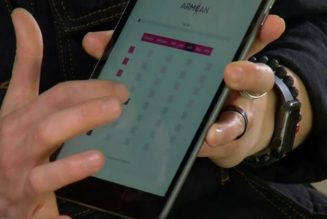Tomorrow, a US spacecraft more than 200 million miles from Earth will sneak up to an asteroid larger than the Empire State Building and snag a handful of rocks from its surface. If all goes to plan, the spacecraft will store the precious cache of rocks inside its belly, and will eventually transport the materials to Earth, where they can be studied by scientists in a lab.
The spacecraft stealing these rocks is called OSIRIS-REx, part of the first-ever NASA mission tasked with returning samples of an asteroid back to Earth. Launched in September of 2016, OSIRIS-REx spent two years traveling to an asteroid named Bennu. Since it arrived in 2018, the spacecraft has been circling the asteroid and mapping it in excruciating detail, in order to find just the right spot to scoop up a sample.
Now, after years of planning and rehearsals, the OSIRIS-REx team is finally ready to grab some asteroid rocks. Their spacecraft will extend a thin robotic arm that will gently tap Bennu’s surface, sweeping a tiny amount of material inside of the vehicle.
Bringing a pristine sample of asteroid material back home would be like providing scientists with a baby picture of the Solar System. Researchers believe that asteroids have remained relatively unchanged since the birth of the system’s planets. By studying these samples with lab equipment, they could learn even more about the materials that were present at the dawn of the Solar System.
But none of that can happen if OSIRIS-REx doesn’t pull off its most important task, which is why tomorrow is such a big day for the mission team. And since it takes up to 18 minutes to get one signal out to OSIRIS-REx at the moment, the spacecraft must execute everything by itself.
“We really have to be hands-off,” Sandy Freund, a mission support manager for OSIRIS-REx at Lockheed Martin, tells The Verge. “The vehicle has to be autonomous and able to take care of everything on its own.”
:no_upscale()/cdn.vox-cdn.com/uploads/chorus_asset/file/21972038/bennu_twelve_image_mosaic.png)
Gathering this sample is a delicate operation — one that has required a ton of extra preparation and work over the last few years. That’s because Bennu turned out to be one heck of a surprise. Data gathered by multiple telescopes before the spacecraft launched made it seem like Bennu had a beach-like surface, filled with lots of fine grains that would be easy to collect. The engineers designed the vehicle and its guidance software with that kind of asteroid in mind.
Then OSIRIS-REx arrived at Bennu and snapped the first up-close images of the asteroid. “Once we started to see the surface of Bennu, we knew that we were going to have to change our approach,” says Freund. Bennu turned out to be much rougher and rockier than everyone had expected, with boulders the size of buildings dotting its surface. Rocky terrain can be tricky to navigate around, and if the spacecraft comes in contact with a particularly large boulder, the vehicle could tip over and veer off course.
However, the team was ready for something unexpected to pop up at Bennu. “[During development] I put up a shape model of Bennu, and I said, ‘This is what we think we’re designing for,’ and I put a big question mark next to it and said, ‘This is what we’re going to get,’” Dante Lauretta, the principal investigator of OSIRIS-REx at the University of Arizona, tells The Verge. “We knew something was going to surprise us.”
The extra-rocky Bennu meant that the OSIRIS-REx team had to add some extra software to their spacecraft. They extended the mission, and spent the extra time creating 3D maps of Bennu’s surface, constructing a catalog of all the rocks, boulders, and bumps located on the asteroid. The vehicle will rely heavily on this catalog as a reference guide when it comes close to Bennu to grab a sample.
“The spacecraft takes pictures, and it compares them to that catalog, and it will notice that: ‘I expected this feature to be here; it’s actually shifted a meter to the west. That means my position is off,’” Lauretta says. In that scenario, OSIRIS-REx will adjust its position and speed accordingly. Such a system allows the spacecraft to be much more precise when it goes in for the final sample grab.
:no_upscale()/cdn.vox-cdn.com/uploads/chorus_asset/file/21972041/Nightingale.png)
The team also gave OSIRIS-REx its own way of aborting the sample collection if things get dicey. Included in its 3D maps is a so-called “hazard map,” which pinpoints all of the boulders and rocks that could pose a problem for the spacecraft when the vehicle comes in close to Bennu. If OSIRIS-REx sees itself approaching one of these hazards, it can decide on its own to stop the sampling process and speed away from the asteroid.
Armed with these tools, the OSIRIS-REx spacecraft is nearly ready to grab a sample from its target spot on Bennu — a large crater called Nightingale. It’s filled with lots of boulders and jagged rock that could muck up the mission. But the team is willing to take the risk, since they think this area may be the best place to find water and organic material on Bennu. In fact, a recent study of the region found that carbon molecules associated with biological life are probably lurking in the crater. That doesn’t mean life is present on Bennu, but it could mean that the building blocks for life could be on the asteroid — and that they were also around when the Solar System was just getting started.
This year, the OSIRIS-REx team did two dress rehearsals, sending the spacecraft close to Bennu’s surface as if it were about to grab a sample. On the second rehearsal, OSIRIS-REx came within just 131 feet (40 meters) of the asteroid. Tomorrow at 6:12PM ET, the spacecraft will do the real thing and travel all the way down to the surface with its robotic arm extended. As part of the plan, a cylindrical device at the end of the arm will gently tap a small spot on Nightingale for just five seconds, releasing a blast of nitrogen gas. That air should push a few rocks up into the cylinder, which will eventually be stored inside the OSIRIS-REx vehicle.
If for some reason OSIRIS-REx goes through the entire process and doesn’t grab a sample, the team can certainly try again. They have enough fuel to hang out at Bennu until May if necessary. The only limiting factor is the nitrogen gas on board the spacecraft. OSIRIS-REx has just three bottles of nitrogen, and one full bottle is released during each sampling attempt. So in reality, OSIRIS-REx can only try for a full sample grab just three times. “We won’t fire a bottle unless we make contact,” says Freund.
There’s also the possibility that OSIRIS-REx will come in close and decide to abort due to a hazardous rock. If that happens, and no nitrogen is released, then the team still has the option to do three full sampling attempts. The problem, though, is that they’ll probably need to pick another spot to sample on the asteroid. OSIRIS-REx will need to fire up its thrusters to zoom away from Bennu in the event of a hazard, and that could make things a little messy.
“It’s probably going to push a bunch of stuff around and you’re going to change the site,” says Lauretta. That would completely invalidate the map the team made for Nightingale.

The engineers have multiple backup sites, though. If Nightingale gets ruined, they’d move on to a site called Osprey, which is actually a little less bumpy than the first target. And if Osprey gets ruined, there are other places to try, too. So really, tomorrow’s sample grab is just the first attempt.
But if the sample grab is a success, then the OSIRIS-REx team is poised to bring back one of the largest samples of material from an asteroid ever retrieved. Two Japanese spacecraft — Hayabusa and Hayabusa 2 — have grabbed samples from asteroids before, but the hauls have been small; the first brought back less than a milligram of rock samples, while the second one — currently en route back to Earth — may return roughly 100 milligrams of samples. OSIRIS-REx is going to try to snag up to 60 grams (2.1 ounces) of material from Bennu, and the vehicle has the capability to grab up to 2 kilograms — our 4.5 pounds. And the spacecraft should be able to determine just how big of a sample it has grabbed, too.
Depending on how large tomorrow’s haul is, the OSIRIS-REx team may decide to do a second try to get even more material. But if they determine they have up to 60 grams of material in the spacecraft’s belly, then they’ll start making the preparations to come home, with plans to leave Bennu in March. That’ll begin a two-year journey back to Earth, with the samples parachuting into the Utah desert in September of 2023.
It’s an incredibly long and complicated way to peer back into the past, with numerous challenges cropping up along the way. For one, all of the rehearsals for the sample grab have taken place this year during the COVID-19 pandemic, with the OSIRIS-REx mission team much more scattered than they had expected. But Lauretta says that everyone has adapted, and they’re ready to take on this enormous task without gathering as planned. He also hopes that their success tomorrow will inspire others during what has been a bleak year.
“We hope that we’re a bit of good news in an era where that’s a little bit in short supply,” says Lauretta. “This is something people can celebrate as a great accomplishment.”










